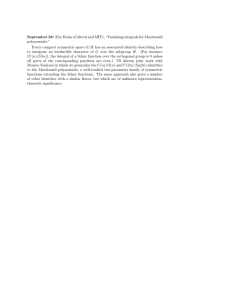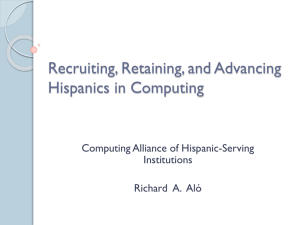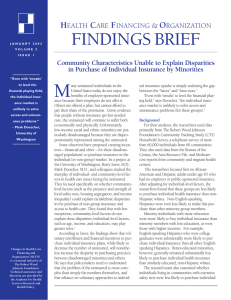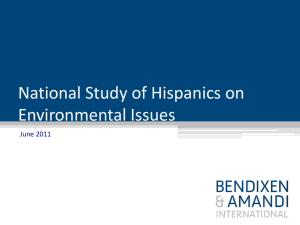A
advertisement
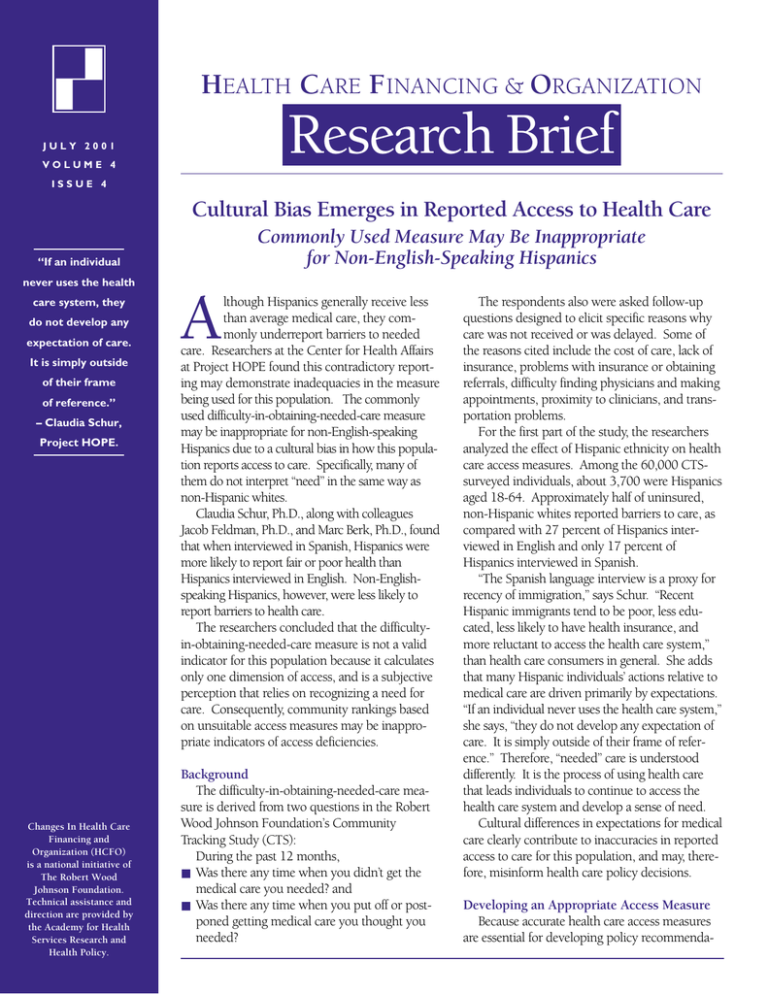
HEALTH CARE FINANCING & ORGANIZATION Research Brief JULY 2001 VOLUME 4 ISSUE 4 Cultural Bias Emerges in Reported Access to Health Care Commonly Used Measure May Be Inappropriate for Non-English-Speaking Hispanics “If an individual never uses the health care system, they do not develop any expectation of care. It is simply outside of their frame of reference.” – Claudia Schur, Project HOPE. Changes In Health Care Financing and Organization (HCFO) is a national initiative of The Robert Wood Johnson Foundation. Technical assistance and direction are provided by the Academy for Health Services Research and Health Policy. A lthough Hispanics generally receive less than average medical care, they commonly underreport barriers to needed care. Researchers at the Center for Health Affairs at Project HOPE found this contradictory reporting may demonstrate inadequacies in the measure being used for this population. The commonly used difficulty-in-obtaining-needed-care measure may be inappropriate for non-English-speaking Hispanics due to a cultural bias in how this population reports access to care. Specifically, many of them do not interpret “need” in the same way as non-Hispanic whites. Claudia Schur, Ph.D., along with colleagues Jacob Feldman, Ph.D., and Marc Berk, Ph.D., found that when interviewed in Spanish, Hispanics were more likely to report fair or poor health than Hispanics interviewed in English. Non-Englishspeaking Hispanics, however, were less likely to report barriers to health care. The researchers concluded that the difficultyin-obtaining-needed-care measure is not a valid indicator for this population because it calculates only one dimension of access, and is a subjective perception that relies on recognizing a need for care. Consequently, community rankings based on unsuitable access measures may be inappropriate indicators of access deficiencies. Background The difficulty-in-obtaining-needed-care measure is derived from two questions in the Robert Wood Johnson Foundation’s Community Tracking Study (CTS): During the past 12 months, ■ Was there any time when you didn’t get the medical care you needed? and ■ Was there any time when you put off or postponed getting medical care you thought you needed? The respondents also were asked follow-up questions designed to elicit specific reasons why care was not received or was delayed. Some of the reasons cited include the cost of care, lack of insurance, problems with insurance or obtaining referrals, difficulty finding physicians and making appointments, proximity to clinicians, and transportation problems. For the first part of the study, the researchers analyzed the effect of Hispanic ethnicity on health care access measures. Among the 60,000 CTSsurveyed individuals, about 3,700 were Hispanics aged 18-64. Approximately half of uninsured, non-Hispanic whites reported barriers to care, as compared with 27 percent of Hispanics interviewed in English and only 17 percent of Hispanics interviewed in Spanish. “The Spanish language interview is a proxy for recency of immigration,” says Schur. “Recent Hispanic immigrants tend to be poor, less educated, less likely to have health insurance, and more reluctant to access the health care system,” than health care consumers in general. She adds that many Hispanic individuals’ actions relative to medical care are driven primarily by expectations. “If an individual never uses the health care system,” she says, “they do not develop any expectation of care. It is simply outside of their frame of reference.” Therefore, “needed” care is understood differently. It is the process of using health care that leads individuals to continue to access the health care system and develop a sense of need. Cultural differences in expectations for medical care clearly contribute to inaccuracies in reported access to care for this population, and may, therefore, misinform health care policy decisions. Developing an Appropriate Access Measure Because accurate health care access measures are essential for developing policy recommenda- tions, the researchers set out to develop an alternative access measure for non-English-speaking Hispanics’ ability to obtain needed care. The result was the utilization-health status access measure, which evaluates actual medical care received relative to health status based on an insured population of all races. Rather than evaluating a subjective response to whether someone received the care they thought they “needed,” the researchers examined more objective criteria - how many times someone spent the night in a hospital and how often they had difficulty climbing a set of stairs, for example. The utilization-health status access measure depends less on the medical sophistication of Hispanics and more accurately captures deficiencies in their access to care. Schur and colleagues compared the utilization-health status results of the insured population with other populations, particularly uninsured Hispanics. The extent to which these other populations fell short of “normal” utilization (experienced by the insured population) constituted the “proxy” for unmet need. To calculate the utilization component of their measure, Schur and colleagues used indicators from the CTS database, such as the number of: ■ physician visits; ■ nights in a hospital; ■ medical professional (e.g., physician assistant, midwife, etc.) visits; and ■ emergency room visits without admission. For the health status piece of the measure, the researchers used a corresponding series of health status components, including both physical and mental health indicators. These indicators included whether respondents had difficulty climbing stairs, whether they experienced low energy levels, or whether pain interfered with their work. Analysis of Community Variation In a second part of the study, the researchers explored the extent to which the Hispanic population accounts for variation across communities in the difficulty of obtaining care. They evaluated whether and to what extent the ranking of communities (in terms of ability to obtain medical care) changes when different measures of access are used. The researchers then replicated the analysis of community variation in access to care in previous work by Peter J. Cunningham, Ph.D., and Peter Kemper, Ph.D., at the Center for Studying Health System Change (HSC).1 The HSC study used data from the CTS survey with a focus on 12 high-intensity communities (populations of 200,000 or more). Cunningham and Kemper concluded that location of residence factors significantly in the ability of the uninsured to access medical care. In this study, variation by community was measured by reported difficulty in obtaining medical care, including the influence of health status and other characteristics on such variation. Schur and colleagues took this data and analyzed changes in community rankings based on two other measures: physician visits and having a usual source of care. Using the HSC analysis, they produced comparable national estimates of difficulty obtaining needed care for the uninsured population and for each of the 12 high-intensity communities. By substituting reported difficulty in obtaining needed care with these two other access measures, they discovered that community rankings changed substantially.2 For example, of the 12 communities studied using the difficulty-inobtaining-needed-care measure, Newark, N.J., had the lowest percentage of persons reporting difficulty and Orange County, Calif., had the second lowest. When the researchers measured these communities using the number of physician visits, however, Newark ranked eighth and Orange County was 12th (last). The researchers concluded, therefore, that for non-English-speaking Hispanics, or for other groups with different norms for using health care, the current CTS community rankings may not be an accurate measure of disparities in access across communities. Lessons for Research Researchers must consider cultural characteristics and experiences when analyzing health care access data. Moreover, according to Schur, researchers must be careful when making crosscultural comparisons using the difficulty-inobtaining-needed-care access measure. For policymakers, the utilization-health status measure may be more useful. If policymakers are interested in strategies for reducing actual disparities in care, notes Schur, then they may find less subjective, traditional access measures (i.e., physician visits) more valuable. What is important for appropriate policy development is that vulnerable populations, such as Hispanics, are growing and are experiencing significant barriers to health care access. ■ HCFO RESEARCH BRIEF JULY 2001 Cultural differences in expectations for medical care contribute to inaccuracies in reported access to care for this population, and may misinform health care policy decisions. ACADEMY FOR HEALTH SERVICES RESEARCH AND HEALTH POLICY 1801 K Street, NW Suite 701-L Washington, DC 20006 Tel: 202-292-6700 Fax: 202-292-6800 Web: www.hcfo.net E-mail: HCFO@ahsrhp.org Program Director Anne K. Gauthier Deputy Director Deborah L. Rogal 1 Cunningham PJ, Kemper P. “Ability to Obtain Medical Senior Research Manager Jason S. Lee, Ph.D. Care for the Uninsured: How Much Does It Vary Across Communities?” JAMA 1998 Sept. 9, 280 (10): 921-7. Editor Carole C. Lee 2 Schur’s findings are generally consistent with unpublished findings by Peter Cunningham and Heidi Whitmore, “How Well Do Communities Perform on Access to Care for the Uninsured?” For more information, contact Claudia L. Schur, Ph.D., at the Center for Health Affairs at Project HOPE, 301-656-7401. Assistant Editor LeAnne B. DeFrancesco Writer Bonnie J. Austin, J.D.
